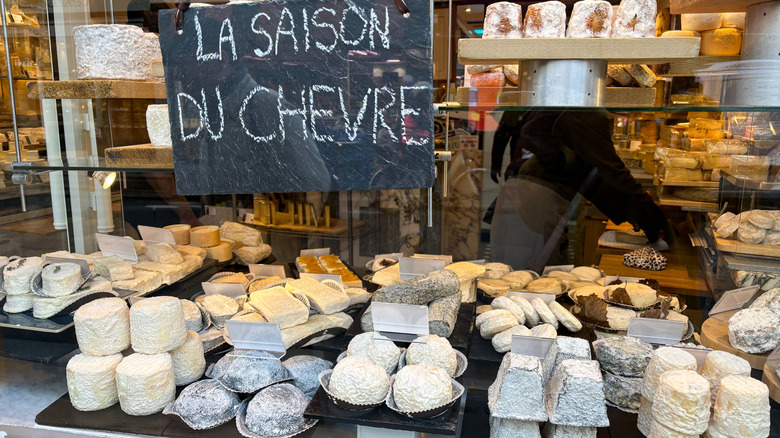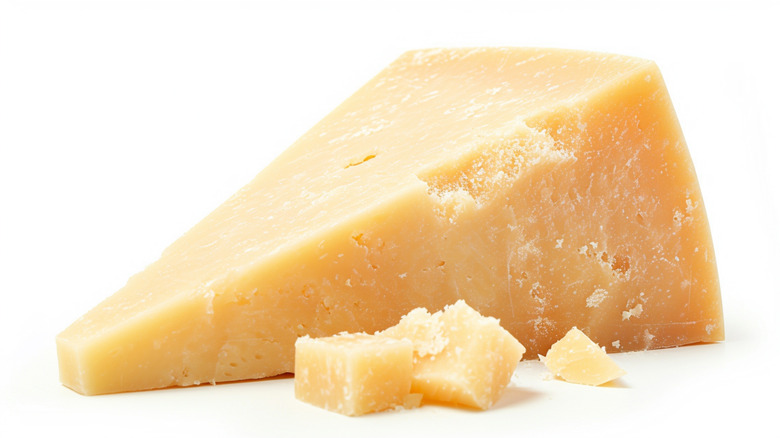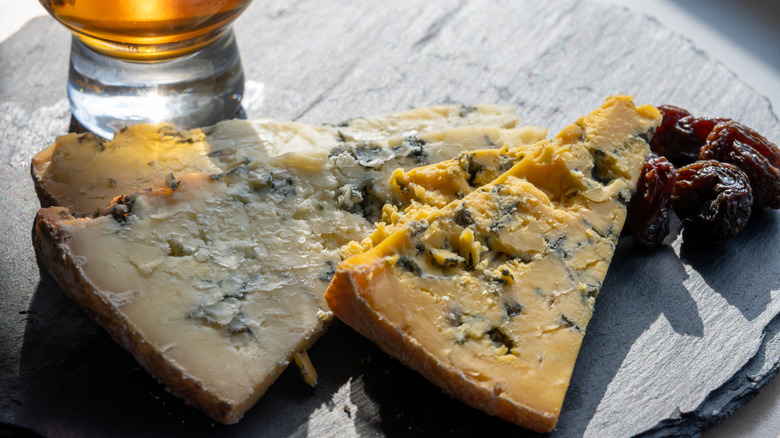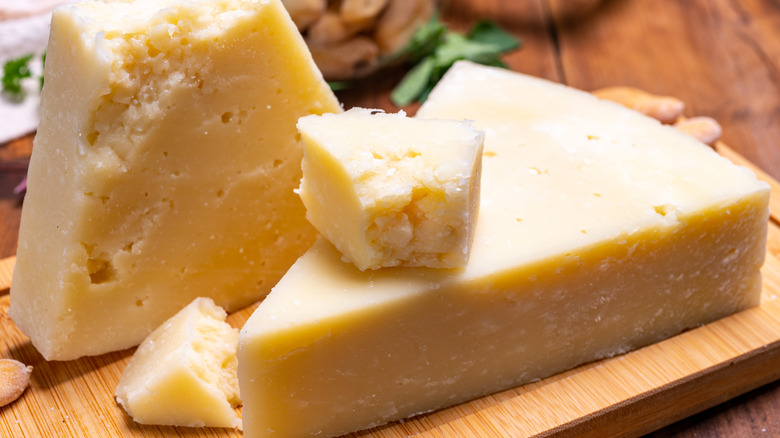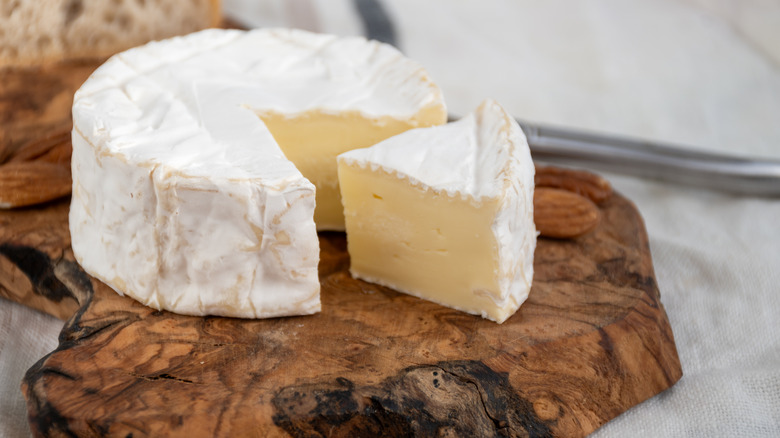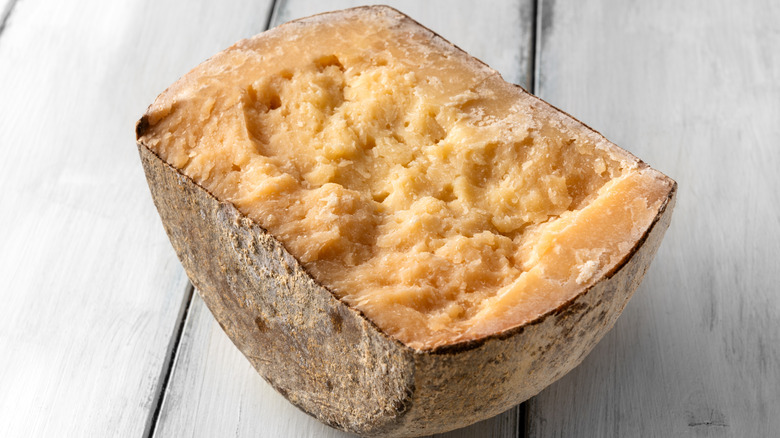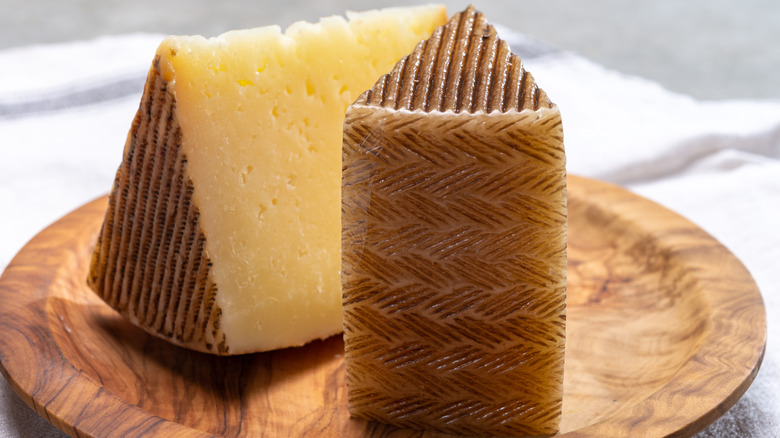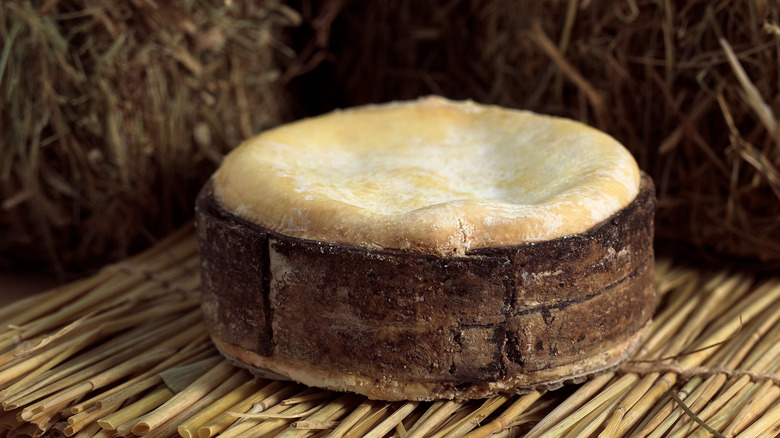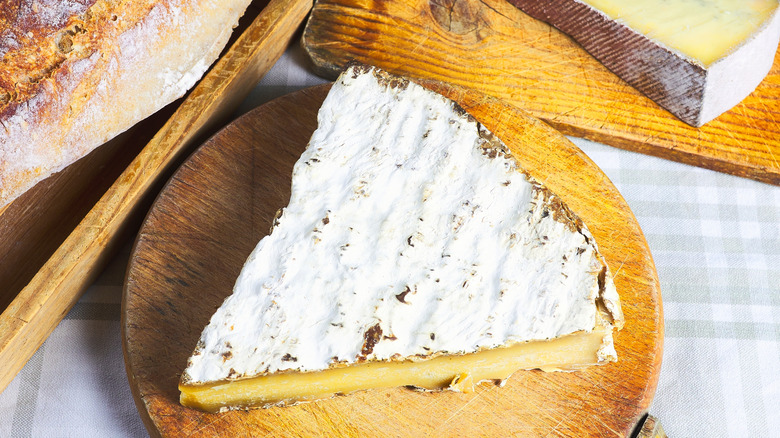10 Popular Cheeses That Aren't Vegetarian-Friendly
For vegetarians who love eating cheese, look closely at the packaging next time you're at the grocery store. You may be surprised to see that many types of cheese, including Swiss, cheddar, and brie, actually contain animal rennet, which is typically found in the stomach lining of dairy-consuming calves, young goats, and lambs. Rennet is produced in the animals before they're mature and while their diets consist mainly of milk. The chymosin enzyme found in animal rennet breaks down the protein in milk, causing coagulation to form the curds that become cheese.
The good news is that many cheesemakers produce vegetarian cheese using non-animal-based rennet found in plants such as nettles, artichoke flowers, fig leaves, and cardoon thistle. This plant-derived rennet works similarly to its non-vegetarian counterpart, although many traditional cheesemakers argue that animal rennet is superior. It's said that animal rennet is preferred when producing types of cheese that need to undergo a longer aging process, as plant-based enzymes can result in an off-putting bitter taste after six months.
While you'll have no problem finding vegetarian cheeses in markets, animal rennet is still heavily used by many European cheesemakers who prefer to take a more traditional, authentic approach to their craft. The majority of Italian DOP, Swiss AOP, and French AOP cheeses still contain animal rennet, using recipes that are protected by their designations of origin. The following types of cheeses aren't vegetarian-friendly and will be clearly labeled when you purchase them at your local market or gourmet cheese shop.
1. Parmigiano-Reggiano PDO
One type of cheese that's always produced using animal rennet is Parmigiano-Reggiano PDO, a product of the Italian Protected Designation of Origin (PDO). It's the only cheese that is approved to be stamped with the Parmigiano-Reggiano mark, which distinguishes it from all other types. Parmigiano-Reggiano is a cooked hard cheese produced with raw cow's milk from animals that typically only consume local fodder, which helps give it its distinctive taste. This type of non-vegetarian cheese dates back to the Middle Ages and Benedictine and Cistercian monks who resided in Italy's Po Valley. Today, the delicious cheese is still produced using essentially the same method as back then, and consists of the original ingredients of milk, animal rennet, and salt.
Traditionally, Parmigiano-Reggiano isn't sliced, but cut into pieces using a classic almond-shaped knife that is pressed into the cheese to break off small pieces. The cheese is produced in the provinces of Parma, Modena, Bologna, and Reggio Emilia, and is ripened on wood shelves in a humidity-controlled environment for anywhere from 12 months to two years. Parmigiano-Reggiano PDO is known for its natural golden hue, hard texture, and fragrant aroma. It has a delicate, nutty flavor and is ideal for shaving over rich and savory pasta dishes, and its rind can help infuse broths with some much-needed umami. Here's a recipe for an easy-to-make Parmesan broth for when you crave a bowl of an Italian-inspired soup.
2. Stilton PDO
Stilton PDO, a rich and intensely flavored cheese with distinctive blue marbling, is required by law to be produced by only six producers in three counties of England: Derbyshire, Nottinghamshire, and Leicestershire, using pasteurized cow's milk. Dating back to the early 18th century in Cambridgeshire, Stilton remains a popular cheese made with animal rennet today. Not only is Stilton pleasing to the eye, but it's also a delight for your palate. It is known for its complex, salty flavor with nutty notes. During the Stilton cheesemaking process, a special yeast is used that allows mold to develop and grow quickly. After the curd forms, cheesemakers pierce it with steel needles to encourage the growth of the well-known blue veins. After aging for a specific duration, the cheese achieves a soft, crumbly texture that is easy to spread on crackers.
Stilton is a very versatile cheese and can easily become the star of any cheese board. The blue cheese works especially well with a variety of dried fruits, nuts such as pecans and walnuts, apples, grapes, and drizzles of honey. You can also use Stilton PDO to add flavor and richness to pasta dishes, risotto, marinara and Alfredo sauces, and crumble it over fresh garden salads. The cheese's pungent, earthy flavor complements sweeter red wines, including port wine, dolcetto, and some styles of merlot. You can also get creative in the kitchen by using Stilton to spruce up a boring meatloaf.
3. Pecorino Romano PDO
In accordance to Italy's Protected Designation of Origin law, pecorino Romano PDO must be produced using animal rennet and 100% Italian sheep's milk from certain geographical areas. This hard, flavorful cheese received the PDO status in 1996 and is crafted primarily in the regions of Lazio, the province of Grosseto in Tuscany, and Sardinia. Pecorino Romano PDO is known for its milky-white color, and may feature a neutral-hued or black rind. The cheese has long been revered for its salty, tangy, and nutty flavor, and may even have sweet and smoky notes. Pecorino Romano is also umami-rich and has a hard, granular texture that makes it ideal for grating.
Similar to Parmigiano-Reggiano, pecorino Romano is often used to flavor Italian-inspired dishes, from pasta to soup. It can also add richness when melted into sauces. Also like Parmigiano-Reggiano, chefs often use the rind of pecorino Romano to infuse soup with intense flavor. You can also shave the Italian cheese over fresh salads and bread, or any dish that needs a bright, tangy touch. On a cheese board, pecorino Romano complements sweet fruits such as grapes and apples, jams and preserves, nuts, breads, crackers, deli meat, and even chocolate. When wrapped and stored properly, this cheese can last several weeks in your refrigerator, and can even be frozen for longer storage.
4. Camembert de Normandie
The pungent, bloomy rind and soft, creamy interior of Camembert de Normandie PDO makes it a popular cheese in Normandy, France, where it is produced, and all throughout the world. The cheese's PDO designation ensures that it's made using traditional methods with animal rennet, unpasteurized cow's milk, and a yeast culture during the coagulation process. The cream-colored cheese is beloved for its delicate, buttery flavor with notes of foraged mushroom and its smooth, creamy texture, making it one of France's most popular cheeses. While Camembert de Normandie is related to brie, it has a slightly more intense taste and isn't a triple-cream cheese. During the cheesemaking process, Camembert de Normandie is typically stored on shelves and rotated regularly to ensure that the mold grows evenly and that the interior is creamy.
You can use the elegant cheese in a wide variety of ways, including on a charcuterie board filled with a selection of nuts, fruit, meat, and other types of cheese. Here's the vital safety rule your charcuterie board should follow. Camembert de Normandie can be baked and used as a decadent dipping sauce for fruit, vegetables, or bread. Spread it on crusty French or Italian bread as a snack or appetizer, or slice it onto fresh green salads as a rich, creamy touch. When drizzled with honey or served with a fruit chutney, the cheese transforms into a gourmet dessert. For the best flavor and texture, bring the cheese to room temperature before enjoying.
5. Emmentaler AOP
Emmentaler AOP is known as the original Swiss cheese and dates back more than eight centuries, when it was first produced in Switzerland's Emmen Valley. The cheese has the same unique flavor and holey appearance today, as it's still being produced according to the original recipe under the country's AOP label. At this time, there are 135 artisanal cheese dairies allowed to produce Emmentaler AOP, and they must use animal rennet and fresh, raw milk produced from grass-fed cows. The unique, full-flavored cheese is made in 200-pound wheels, and is aged for a minimum of four months.
Beloved for its firm yet supple texture and distinctive holes, Emmentaler AOP has a unique nutty flavor with just a hint of acidity and slightly herbal notes. One wheel of this unique cheese features up to 2,000 holes, which are naturally formed during its ripening process. Find out here why the size of Swiss cheese holes matters. The use of additives and genetically modified organisms is prohibited during the production of Emmentaler AOP. This cheese makes a tasty addition to charcuterie boards alongside fresh fruit such as apples and pears, berry jams and spreads, vegetables, sliced deli meats, and crusty bread. Roasted nuts, including walnuts, pecans, and cashews, also complement the cheese's delicious nutty flavor.
6. Charolais
One of France's largest goat cheeses, Charolais obtained PDO status in 2010 and is required to be produced with whole raw milk and animal rennet. The semi-soft cheese with a pleasant, firm texture originated in the Bourgogne region of France and is known for having a slightly acidic bite along with a delightful salty and sweet flavor combination. Charolais has the subtle taste of goat's milk, and is matured for a minimum of two weeks. During the aging process, the cheese's ivory rind develops blue-colored spots. You can enjoy the cheese when it's young or just partially matured, but its unique flavor becomes more pronounced and intense as it ages into a fully matured product. The barrel-shaped cheese is served in a variety of ways, and blends well with several other foods.
Serve the cheese at room temperature so that you can experience its full flavor, and keep it in its original packaging until you're ready to eat it so it doesn't dry out. Since Charolais has such a rich texture and intense flavor, it's best served with refreshing cucumbers, celery sticks, or a garden salad. It also pairs well with salami and other types of deli meats on a cheese board, along with dried and fresh fruit, and nuts. If you want to wash Charolais down with wine, go with a white or full-bodied red one, such as a vintage Champagne or cabernet sauvignon.
7. Pecorino sardo PDO
Pecorino sardo PDO was given the Denomination of Origin status in 1991, and is only produced with whole sheep's milk from Italy's Sardinia region. The sheep only eat the vegetation on the island's pastures, meadows, and grasslands, resulting in a high-quality product with a uniform flavor profile. The hard cheese, which features both a crumbly and smooth texture, has a sweet aroma and a unique nutty taste. Pecorino sardo PDO is available in both mild and mature versions, which feature different processing techniques, sizes, and characteristics. Also known as fiore sardo, this cheese has a slightly sweet taste with a hint of smokiness that comes from the wood-burning stoves in the buildings where it undergoes its maturing process.
Like other full-flavored, hard Italian cheeses, pecorino sardo can be enjoyed in a wide variety of ways. Grate it over pasta dishes, such as spaghetti, lasagna, and ravioli, or incorporate it into pesto, Alfredo, and marinara sauces. You can also eat it in cubes or slices with crackers, bread, nuts, deli meats, and dried and fresh fruit on charcuterie boards. Get creative by combining pecorino sardo with other cheeses, such as mozzarella, on a grilled cheese. Here's a simple way to make a super crispy and buttery sandwich. When it comes to wine pairing, the cheese works best with a full-bodied Italian red vintage.
8. Manchego PDO
As authentic a cheese as it gets, delicious manchego can only be produced in the La Mancha region of Spain, which was brought to fame by Don Quioxte and his pal Sancho Panza. The chivalrous main character isn't the only famous thing to come out of the area, however, as full-flavored manchego is loved all around the world. Although manchego has been produced for centuries, it didn't obtain its PDO status until 1984.
The cheese is only produced using animal rennet, along with rich milk produced from the manchego sheep breed, which feed on the region's wild grasses and shrubs. The rind derives its distinctive zigzag pattern from an imprint on the molds that is designed to resemble esparto basket weaves. The rinds are then sealed or rubbed with olive oil to lock in the design.
Young manchego has a mild, mellow flavor that grows in intensity the longer it's aged. Manchego semi-curado is aged from three weeks to three months and has a semi-firm texture, while manchego curado is aged between three and six months and is smooth with a mild nutty flavor. Manchego viejo is aged for one year, has a yellow color, and a bright, peppery bite that isn't as noticeable in the other types. Serve the cheese as part of an appetizer or tapas spread with fruit, other cheeses, and meats, or with olives, French bread, and an herb vinaigrette. Manchego also blends well with a variety of fresh and dried fruit.
9. Vacherin Mont-d'Or
Featuring a silky and luscious texture, Vacherin Mont-d'Or is only produced in France or Switzerland from milk produced from cows from October through April. Under the Protected Designation of Origin status, which Vacherin Mont-d'Or earned in 2003, the cows used in the cheesemaking process must graze on straw and fodder in regional pastures. The cheese can only be made at elevations of 2,297 feet or higher, and must be encircled with strips of spruce bark, and then stored on spruce boards, to give it a unique, woodsy flavor. After the Vacherin Mont-d'Or is aged for a specific length of time, it is then placed into spruce boxes. This extreme attention to detail ensures a high-quality product that is sought after worldwide.
Vacherin Mont-d'Or has a softy and gooey texture, and is easily spreadable when brought to room temperature. It's pure cheese heaven when spread onto slices of crusty bread or salty crackers. You can also bake Vacherin Mont-d'Or by removing it from its storage box and other packaging, placing it onto a baking sheet, and then dousing it with a bit of white wine. Bake the cheese for 20 to 30 minutes, or until it's soft and melty. Serve with bread or on top of boiled potatoes as a real treat.
10. Brie de Meaux
In order for Brie de Meaux to be granted its highly esteemed name from the AOC, a distinction that's only been granted to 40 French cheeses, it must be completely produced and ripened in specified regions of Marne, Yonne, Seine-et-Marne, Loiret, Aube, Haut-Marne, and Meuse. Blessed with a sweet and buttery flavor, Brie de Meaux has notes of almonds, mushrooms, and a rich, milk aroma. This classic cheese has been produced for approximately 400 years, but became popular in the 19th century when it was served at a diplomat's dinner. Brie de Meaux is made with only raw cow's milk and animal rennet, and is produced both industrially and artisanally in small batches.
The cheese's smooth and creamy texture makes it ideal for spreading on breads and crackers, and it should be served at room temperature for optimum flavor. If you're including Brie de Meaux on a cheese board, cut it into small wedges and serve it alongside fresh fruits such as apples, grapes, and pears, as well as roasted nuts. You can also use it to make a decadent grilled cheese sandwich, or incorporate it into salads for a touch of creaminess and extra protein. It's also ideal for topping gourmet pizzas and a variety of pasta dishes. Brie de Meaux pairs well with mild white wines such as chardonnay, as well as fruity red vintages and blonde ales. If you don't finish all of your brie at once, here's how long it will stay good for after opening.
